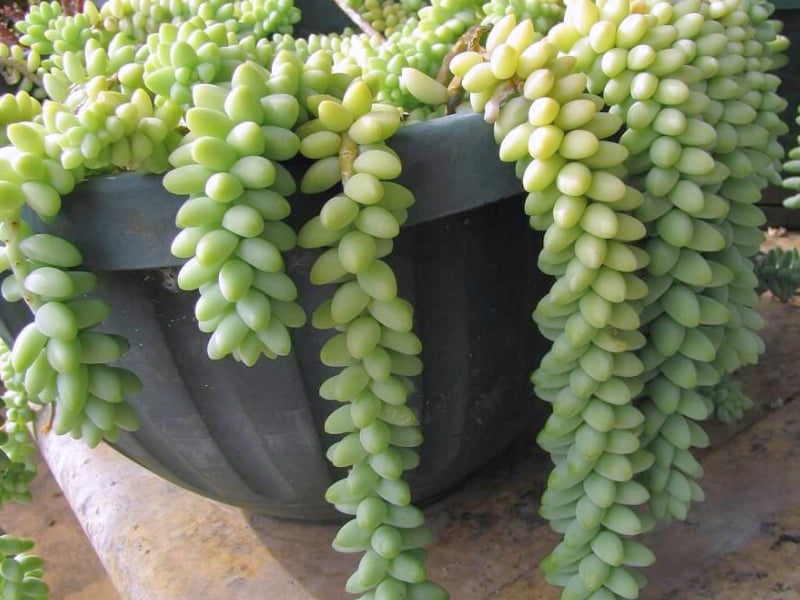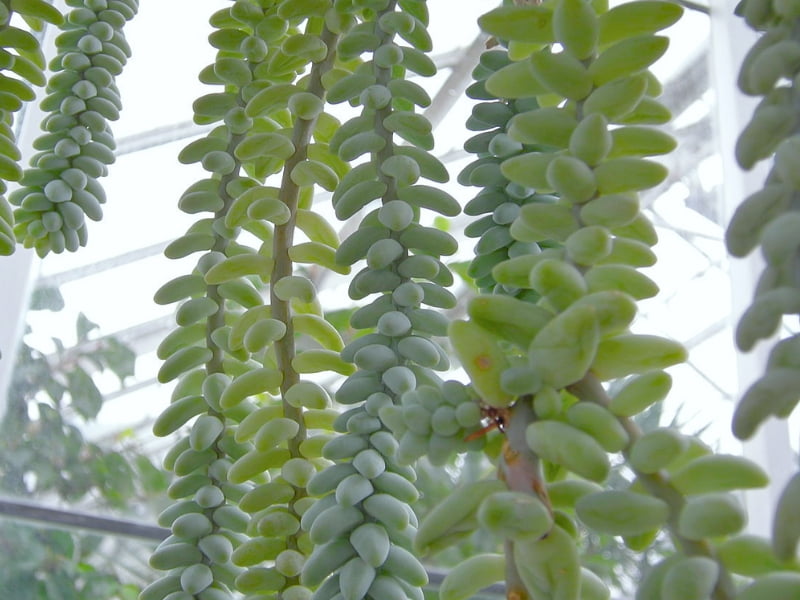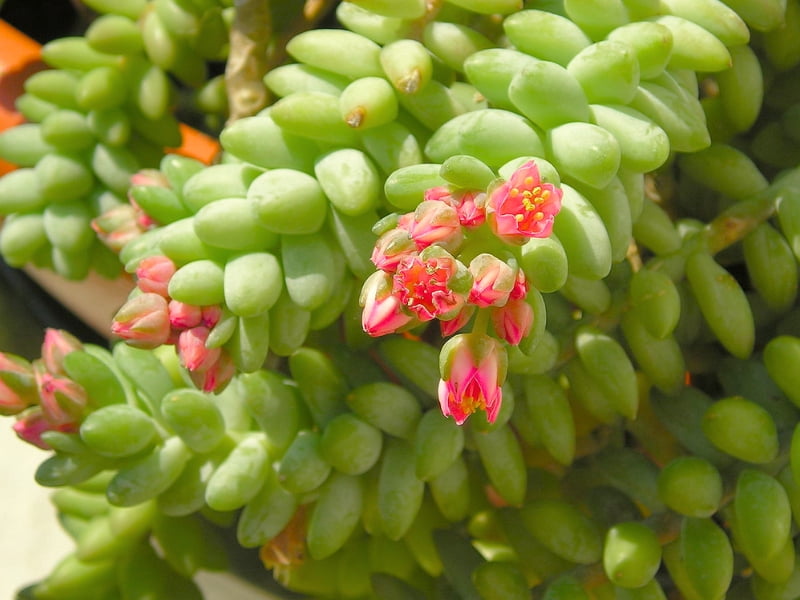Donkey’s Tail, also commonly known as Burro’s Tail or Sedum morganianum, is a captivating succulent prized for its trailing stems adorned with plump, blue-green leaves. This visually striking plant, native to Mexico, is a favorite among houseplant enthusiasts and gardeners in warmer climates, offering a unique textural element to any collection.
At Gardencenterpoint.com, we understand the desire to cultivate these beautiful Sedum morganianum plants successfully. This guide provides everything you need to know, from basic care to advanced propagation techniques, to help your Burro’s Tail (Donkey’s Tail) thrive, and to ensure you are prepared whether you are looking to buy a Donkey’s Tail plant or learn everything about Donkey’s Tail care.

What is Donkey’s Tail Plant?
Donkey’s Tail is a member of the Crassulaceae family, a large group of succulents known for their water-storing capabilities. This adaptation allows them to tolerate periods of drought, making them relatively low-maintenance plants. However, understanding their specific needs is crucial for optimal growth and appearance. The characteristic trailing stems can reach lengths of up to four feet in ideal conditions, creating a cascading effect that’s perfect for hanging baskets or elevated planters.
| Common Name | Donkey’s Tail, Burro’s Tail, Horse’s Tail, Lamb’s Tail |
| Botanical Name | Sedum morganianum |
| Family | Crassulaceae |
| Genus | Sedum |
| Species | morganianum |
| Origin | Southern Mexico, Honduras |
| Life Cycle | Perennial |
| Plant Type | Succulent |
| Hardiness Zone | Typically 9-11 (can tolerate brief periods down to zone 8 with protection) |
| Sunlight | Bright, indirect light; tolerates some shade, but best color and growth with ample light. |
| Maintenance | Low |
| Water | Low; allow soil to dry completely between waterings. |
| Drainage | Well-drained; essential to prevent root rot. |
| Spacing | 12-18 inches (when planted as ground cover or in mixed arrangements). |
| Flowering Period | Spring (although flowering is infrequent indoors) |
| Height | Trails up to 4 feet long (in ideal conditions) |
| Growth Rate | Slow to Moderate |
| Flower Color | Pink, Red (small, star-shaped flowers) |
| Stem Color | Green, often with a bluish or grayish tinge due to farina. |
| Leaf Color | Blue-green, often with a powdery coating (farina). |
| Garden Style | Rock Garden, Xeriscape, Container Garden, Hanging Basket |
| Uses | Ornamental, Hanging Baskets, Container Plant, Ground Cover (in suitable climates) |
| Soil pH | Prefers slightly acidic to neutral (6.0-7.0) |
| Propagation | Leaf cuttings, Stem cuttings |
| Toxicity | Generally considered non-toxic to humans and pets by the ASPCA, but ingestion may cause mild stomach upset. |
| Drought Tolerance | High |
| Pest and Disease Resistance | Relatively resistant, but susceptible to mealybugs, aphids, and root rot if overwatered. |
The leaves of Sedum morganianum are typically a pale blue-green color, often with a powdery coating called farina. This coating helps protect the plant from intense sunlight and should be handled with care, as it can be easily rubbed off. The leaves are tightly packed along the stems, resembling a braided tail – hence the common names. While Donkey’s Tail can produce small, pink or red flowers in the spring, it’s primarily grown for its striking foliage.
A study published in the journal HortTechnology in 2018 examined the growth responses of various succulent species, including Sedum morganianum, to different light intensities. The results showed that while Donkey’s Tail can tolerate low light conditions, it exhibits the best growth and coloration under bright, indirect light. This reinforces the importance of proper light placement for optimal health. This adaptable plant makes it a suitable candidate for propagation. Propagating a plant means to reproduce it asexually, creating a genetic clone that can be shared with another or added to increase the beauty of one’s garden.
Essential Donkey’s Tail Care
Providing the right environment is paramount to the success of your Donkey’s Tail. Here’s a breakdown of the key elements:
Light Requirements
Donkey’s Tail thrives in bright, indirect light. A south-facing window with a sheer curtain or an east-facing window is ideal. Direct, intense sunlight can scorch the leaves, especially during the hottest part of the day. Insufficient light, on the other hand, will lead to etiolation, where the stems stretch and become leggy, with increased spacing between the leaves.
Signs of Too Much Light: Yellowing or browning of leaves, especially on the sides exposed to the sun.
Signs of Too Little Light: Stretched stems, pale leaves, and increased spacing between leaves.
If you’re unsure about the light levels in your home, consider using a light meter app on your smartphone to get a more accurate reading. Aim for at least 4-6 hours of bright, indirect light per day. During Winter months, when light can become scarce, you can supplement the plant’s needs with a grow light.
Watering
As a succulent, Donkey’s Tail is highly susceptible to overwatering. The key is to allow the soil to dry out completely between waterings. This “soak and dry” method mimics the natural conditions in its native habitat.
Watering Frequency: Varies depending on the season, temperature, humidity, and pot size. In general, water thoroughly when the soil is completely dry, which may be every 2-4 weeks in the summer and even less frequently in the winter.
How to Water: Pour water directly onto the soil until it drains out of the bottom of the pot. Avoid getting water on the leaves, as this can lead to rot or fungal diseases.
Signs of Overwatering: Yellowing, mushy leaves that fall off easily; black or brown spots on the stems.
Signs of Underwatering: Shriveled, wrinkled leaves; leaves that feel dry and crispy.
A good rule of thumb is to stick your finger about an inch into the soil. If it feels dry, it’s time to water. If it’s still moist, wait a few more days.
Soil and Drainage
Well-draining soil is absolutely essential for Donkey’s Tail. Standard potting mix retains too much moisture, which can lead to root rot. Instead, use a specialized succulent or cactus mix, or create your own by combining potting mix with perlite, coarse sand, or pumice.
Recommended Soil Mix: A blend of 1 part potting mix, 1 part perlite, and 1 part coarse sand provides excellent drainage.
Potting Considerations: Choose a pot with drainage holes to prevent water from accumulating at the bottom. Terracotta pots are a good option because they are porous and allow for better airflow to the roots.
Good drainage is arguably the most critical factor in preventing root rot, a common problem with succulents.
Temperature and Humidity
- Temperature Preferences:
Donkey’s Tail prefers average to warm temperatures, ideally between 65°F and 75°F (18°C – 24°C). It can tolerate temperatures down to about 50°F (10°C) for short periods, but prolonged exposure to cold can damage the plant. Avoid placing it near drafts or air conditioning vents. - Humidity Needs:
Unlike many tropical houseplants, Donkey’s Tail does not require high humidity. It thrives in average household humidity levels. In fact, excessively humid conditions can increase the risk of fungal diseases.
Fertilizing Donkey’s Tail
- Fertilizer Type:
Use a balanced, water-soluble fertilizer diluted to half strength. A fertilizer specifically formulated for succulents or cacti is ideal. - Fertilizing Schedule:
Fertilize sparingly, only during the active growing season (spring and summer). A single application in early spring and another in mid-summer is usually sufficient. Avoid fertilizing in the fall and winter when the plant is dormant. - Over-Fertilizing Risks:
Excessive fertilizer can cause salt buildup in the soil, which can damage the roots and lead to leaf burn. Always err on the side of under-fertilizing rather than over-fertilizing.
Repotting Donkey’s Tail
- Repotting Frequency:
Donkey’s Tail is a relatively slow-growing plant and doesn’t need to be repotted frequently. Repotting is typically necessary only when the plant becomes root-bound, meaning the roots have filled the pot and are starting to circle around the bottom. - Signs of Root-Bound:
- Roots emerging from the drainage holes.
- The plant becoming top-heavy and easily tipping over.
- Slower growth.
- Water draining through the pot very quickly.
- The Repotting Process:
- Choose the Right Pot: Select a pot that is only slightly larger (1-2 inches in diameter) than the current pot. Ensure it has drainage holes.
- Prepare the Soil: Use a fresh batch of well-draining succulent or cactus mix.
- Gently Remove the Plant: Carefully loosen the soil around the edges of the pot and gently lift the plant out. Avoid pulling on the stems, as they are fragile.
- Inspect the Roots: Check for any signs of root rot (soft, brown roots). If you find any, trim them away with sterile scissors or pruning shears.
- Plant in the New Pot: Place a layer of soil at the bottom of the new pot, then center the plant and fill in around the roots with more soil. Gently firm the soil.
- Water Lightly: Wait a few days before watering lightly to allow the roots to settle.

Propagating Donkey’s Tail
Donkey’s Tail is remarkably easy to propagate, making it a fun and rewarding project for gardeners of all levels. There are two primary methods: stem cuttings and leaf cuttings.
- Stem Cuttings:
- Take Cuttings: Use sterile scissors or pruning shears to cut a healthy stem, ideally 4-6 inches long.
- Allow to Callus: Let the cut end dry and callus over for a few days. This helps prevent rot when planted.
- Plant the Cutting: Insert the calloused end into well-draining succulent or cactus mix.
- Water Sparingly: Water lightly only when the soil is dry.
- Provide Bright, Indirect Light: Place the cutting in a location with bright, indirect light.
- Root Development: Roots typically develop within a few weeks. You can gently tug on the cutting to check for resistance, which indicates root growth.
- Leaf Cuttings:
- Gently Remove Leaves: Twist or gently pull healthy leaves from the stem. Make sure to get the entire leaf, including the base.
- Allow to Callus: Let the leaves dry and callus over for a few days.
- Place on Soil: Lay the calloused leaves on top of well-draining succulent or cactus mix.
- Mist Occasionally: Mist the leaves lightly every few days, but avoid overwatering.
- New Growth: Small plantlets will start to develop at the base of the leaves within a few weeks.
- Separate and plant: Once the “mother” leaf begins to shrivel up, you can separate the new plants and plant them in their own containers.
- A study conducted at the University of California, Davis, found that propagating succulents from leaf cuttings under slightly warmer temperatures (around 75°F) resulted in faster root development.
Pests and Diseases
While Donkey’s Tail is generally a hardy plant, it can be susceptible to certain pests and diseases.
- Common Pests:
- Mealybugs: These small, white, cottony insects cluster on stems and leaves, sucking sap and weakening the plant.
- Aphids: Tiny, pear-shaped insects that can be green, black, brown, or red. They also feed on sap and can transmit diseases.
- Spider Mites: Extremely small mites that create fine webbing on the plant. They thrive in dry conditions.
- Pest Control:
- Manual Removal: For small infestations, you can remove pests by hand or with a cotton swab dipped in rubbing alcohol.
- Insecticidal Soap: Insecticidal soap is a safe and effective treatment for many pests.
- Neem Oil: Neem oil is a natural insecticide and fungicide that can help control pests and prevent diseases.
- Common Diseases:
- Root Rot: Caused by overwatering and poor drainage. Symptoms include yellowing, mushy leaves, and a foul odor from the soil.
- Fungal Diseases: Can occur in humid conditions or when water is allowed to sit on the leaves.
- Disease Prevention:
- Proper Watering: Avoid overwatering and ensure good drainage.
- Good Air Circulation: Provide adequate air circulation around the plant.
- Avoid Wetting Leaves: Water the soil directly, not the leaves.
- Fungicides: In cases of severe fungal infections, a fungicide may be necessary. Always follow the product instructions carefully.
Troubleshooting Common Donkey’s Tail Problems
- Dropping Leaves: Leaf drop can be caused by several factors, including overwatering, underwatering, sudden changes in temperature, or handling the plant roughly. Assess your care practices and make adjustments as needed.
- Leggy Growth: This is a sign of insufficient light. Move the plant to a brighter location.
- Yellowing Leaves: Can indicate overwatering, underwatering, or nutrient deficiency. Check the soil moisture and consider fertilizing if necessary.
- Shriveled Leaves: Usually a sign of underwatering. Water the plant thoroughly.
- Brown Spots: Can be caused by sunburn, fungal diseases, or pest damage. Identify the cause and take appropriate action.
Choosing the Right Donkey’s Tail: Varieties and Where to Buy
While Sedum morganianum is the most common Donkey’s Tail, there are a few variations to consider:
- Sedum morganianum ‘Burrito’: This cultivar has smaller, rounder leaves that are more tightly packed together, giving it a more compact appearance.
- Sedum morganianum (Standard): The classic Donkey’s Tail with longer, more pointed leaves.
When purchasing a Donkey’s Tail, look for a plant with healthy, plump leaves and no signs of pests or diseases. Choose a plant that is well-established in its pot.
Gardencenterpoint.com does not directly sell plants, but we help you find the best local nurseries and online retailers that offer healthy Donkey’s Tail specimens. We provide links to reputable sellers, allowing you to compare prices and find the perfect plant for your needs.
Displaying Your Donkey’s Tail
The trailing nature of Donkey’s Tail makes it ideal for a variety of display options:
- Hanging Baskets: This is the most popular way to showcase the cascading stems.
- Elevated Planters: Placing the plant on a shelf or pedestal allows the stems to drape down.
- Wall-Mounted Planters: Create a living wall by mounting several Donkey’s Tail plants in wall planters.
- Mixed Succulent Arrangements: Combine Donkey’s Tail with other succulents in a larger container for a diverse and textured display.
Donkey’s Tail and Pets: A Note of Caution Though not considered a highly toxic plant, it is best to excercise caution around animals. According to the ASPCA (American Society for the Prevention of Cruelty to Animals), Sedum morganianum is considered non-toxic to dogs, cats, and horses. However, ingestion of any plant material can cause mild gastrointestinal upset, such as vomiting or diarrhea. It’s always best to keep houseplants out of reach of pets, especially if they are known to nibble on plants.

Donkey’s Tail Uses and Benefits
Beyond its undeniable aesthetic appeal, Donkey’s Tail offers a range of uses and benefits, both practical and subtle, that make it a valuable addition to any home or garden. While it’s primarily appreciated for its ornamental value, its unique characteristics lend themselves to various applications. This section will explore the different ways you can utilize and enjoy this fascinating succulent.
Ornamental Uses
The primary use of Donkey’s Tail is undoubtedly as an ornamental plant. Its cascading stems and unique texture create a visually striking display, adding a touch of whimsy and natural beauty to any space. Here are some specific ways it enhances aesthetics:
Hanging Baskets: The classic way to showcase Donkey’s Tail, allowing its stems to trail gracefully downwards. This creates a focal point and adds vertical interest.
Elevated Planters: Placing Donkey’s Tail on a shelf, pedestal, or plant stand highlights its cascading form and prevents the stems from touching the ground.
Wall-Mounted Planters: Create a living wall effect by grouping several Donkey’s Tail plants in wall-mounted containers. This is a great way to add greenery to small spaces.
Mixed Succulent Arrangements: Combine Donkey’s Tail with other succulents of varying shapes, colors, and textures to create a diverse and visually appealing display. The contrasting forms create an interesting dynamic.
Terrariums (with Caution): While Donkey’s Tail generally prefers dry conditions, it can be incorporated into open terrariums with excellent drainage and airflow. Careful monitoring of moisture levels is crucial.
Ground Cover (in Suitable Climates): In warm, dry climates (USDA hardiness zones 9-11), Donkey’s Tail can be used as a unique ground cover, spreading slowly and creating a textured carpet. The University of Florida IFAS Extension suggests sedum as a viable, low-maintenance alternative to certain turf grasses.
Air Purification
Like all plants, Donkey’s Tail contributes to air purification by absorbing carbon dioxide and releasing oxygen during photosynthesis. While its contribution is relatively small compared to larger, leafier plants, it still plays a role in improving indoor air quality.
A NASA Clean Air Study, although not specifically testing Sedum morganianum, demonstrated that many common houseplants can remove some volatile organic compounds (VOCs) from the air. While Donkey’s Tail’s impact might be minor, it contributes to the overall effect of having multiple plants indoors.
Stress Reduction and Well-being
The presence of plants, including succulents like Donkey’s Tail, has been linked to reduced stress levels and improved well-being. The visual appeal and the act of caring for plants can have a calming and therapeutic effect.
Research published in the Journal of Environmental Psychology has consistently shown that interacting with nature, even through indoor plants, can lower stress hormones and improve mood. The simple act of observing the growth and beauty of a Donkey’s Tail can contribute to a more positive and relaxed environment.
Educational Opportunities
Donkey’s Tail can be a valuable tool for teaching about plant biology, adaptation, and propagation. Its unique growth habit and easy propagation make it an excellent subject for hands-on learning in classrooms or at home. Children are often captivated by the plant’s unique, tail-like shape.
Gift Giving
A healthy, well-cared-for Donkey’s Tail makes a thoughtful and unique gift for plant lovers or anyone who appreciates natural beauty. Its relatively low maintenance requirements make it a suitable gift even for those without extensive gardening experience. Propagated cuttings, presented in small pots, are a particularly personal and affordable gift option.
Photography and Artistic Inspiration
The unique texture and form of Donkey’s Tail make it a popular subject for photography and artistic inspiration. Its cascading stems and plump leaves create visually interesting patterns and shapes. Close-up photos of the leaves can reveal intricate details and textures.
Drought-Tolerant Landscaping
In regions that experience periods of drought, Donkey’s Tail can provide a beautiful ground cover that requires very little water once it is established. This can help conserve resources without sacrificing curb appeal. In an article published in the journal Water Resources Research drought-resistent plants were described as “low-cost, low-technology solution(s)” to water conservation in urban landscapes.
Erosion Control
Though it does not have an incredibly deep or complex root system, a donkey’s tail planted en masse may offer slight improvements to the sturdiness of a sloped plot of land. Gardencenterpoint.com recommends researching more substantial options if erosion is a significant concern.
While Donkey’s Tail is primarily valued for its ornamental qualities, its benefits extend beyond mere aesthetics. It offers a touch of nature, a sense of calm, and even educational opportunities, making it a worthwhile addition to any plant collection. Remember, Gardencenterpoint.com can help you find the perfect Donkey’s Tail and all the resources you need to care for it.

Leave a Reply